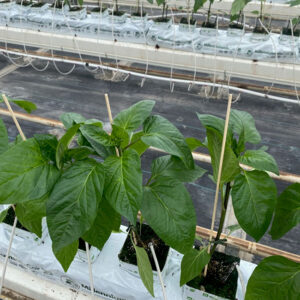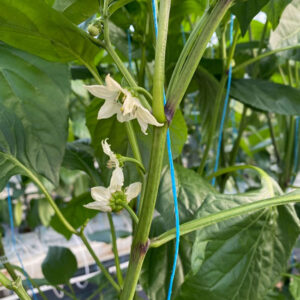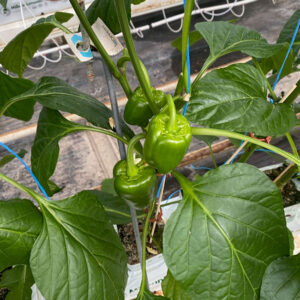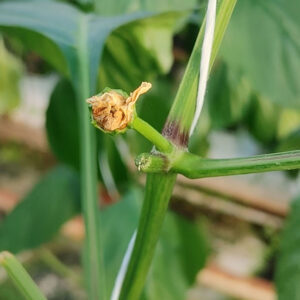
Features
Managing vegetable crops in winter
Part 3: Sweet bell peppers
January 12, 2024 By DR. MOHYUDDIN MIRZA
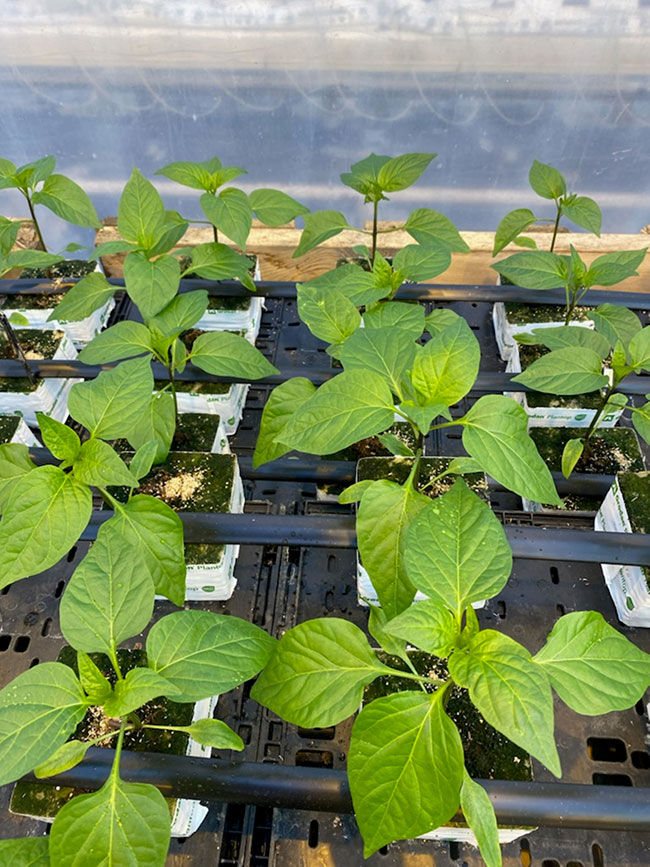 1. Young seedlings, well spaced
All photos, courtesy Mohyuddin Mirza
1. Young seedlings, well spaced
All photos, courtesy Mohyuddin Mirza Peppers are considered to be a tougher crop to grow through winter compared to tomatoes and cucumbers because of managing the balance between vegetative and generative growth. Production schedules have changed over the years. Two cropping systems are followed. One is to bring in 30- to 40- days-old seedlings around the third week of December or early January and start harvest in the beginning of March. Harvest is continued until late November. It takes about 120 days from seeding to harvest and thus cash flow is delayed compared to tomatoes and cucumbers. The second cropping system is to plant seedlings in August, take advantage of good light and then take the crop through winter, using supplemental light and end in late July.
Seedling management
Growing your own seedlings requires ensuring you have a proper area for germination, temperature control, supplemental light of 120 to 160 watts/m2 and easy access to water and nutrients. In order to target fruit set in January, the seeding dates of around October 5 to 10 is suggested. Avoid over crowding and that is why the seeds are germinated in smaller cubes of rockwool or other germination mixes, then moved to larger blocks and spaced out so that the plants are not touching each other.
Most growers get their seedlings from reputable propagators. They are generally around 15 to 20 inches in height with good internode length and well-expanded leaves. The focus is on keeping them vegetative.
Plant density – A plant density of 3.5/m2 is generally used and with two stems the number comes to 6.5 to 7.1 stems/m2. For hot and other small-fruited varieties growers allow many stems to develop.
Production cycle January to February
Plant focus – Focus on building a strong vegetative plant prior to the fruit set at the end of January. Any flowers set in the early phases can be removed to facilitate the plant producing more leaves, roots and shoots. Image 3, on the next page, shows early branching and what flowers should be removed. Images 3 and 4 highlight the point that early flowers can be removed. Some growers do set one fruit at the second and third node and harvest early green fruit.
Target temperatures
- After planting, the 24-hour temperature is reduced to 21°C day and night for two days.
- After the plants have adjusted to the new climate, increase the day temperature to 23°C and night to 21°C.
- Target day temperature by sunrise increasing night to day temperature by 1°C per hour. This temperature ramping helps to avoid condensation.
- Target 24-hour average >20 to 20.5°C for January when light levels are good (>200 joules). For darker periods adjust 24-hour temperature to 19 to 19.5°C. As soon as fruit is set, adjust 24-hour average based on light levels.
- Maintain plant speed especially when natural plant growth slows at the end of January/beginning of February.
CO2 targets
- Target 600 to 800 ppm CO2 in January
- If boiler exhaust is used for CO2, then pay particular attention to the levels of nitrous oxide and ethylene.
Target Vapour Pressure Deficit (VPD)
- Target VPD 3 to 7 grams/m3. VPD is also measured in millibars and Kilopascal. Know what units are being reported by your computer. The range suggested above will maximize cell strength and disease resistance in the developing plants.
- VPD depends on a combination of temperature and relative humidity. So VPD can be adjusted by manipulating temperature and relative humidity.
- In January and February because of limited air exchanges and ventilation roof condensation can easily occur. Using vertical and horizontal fans for air movement is very important.
Light levels
- Allow maximum natural light to come into the greenhouse. Many growers have installed supplemental lights to provide about 200 micromoles of full spectrum lights.
- Condensation on the inside of the greenhouse roof may reduce the light which can affect crop performance.
- Adjust temperature according to the light available. Image 5 is a good picture where set fruit started aborting when the light was below a Daily Light Integral of 12 moles/m2/day
Target irrigation/feed
- Very important to provide adequate amount of nutrient solution. Peppers need higher amounts of boron in feed. My recommendation is using boron levels of around 0.8 to 1.0 ppm.
- In soilless cultivation systems like rockwool or coir, target an EC of around 3.0 in the feed and about 3.5 in the leach. Since higher EC exerts a higher osmotic pressure in the root zone, so plants restrict the amount of water uptake resulting into a balanced plant. EC values are lowered when sunlight goes above 500 joules/cm2
- Avoid ammonium nitrogen use in January and February. Pay particular attention to pH management because when roots are actively growing, the pH will go on the high side and iron and manganese deficiency on young leaves may occur.
Target leaf and fruit numbers
- Target large plants with strong roots and maximum leaf area for optimum photosynthesis.
- Avoid compact plants with short internodes. An internodal distance of six to eight inches is desirable.
- Target first fruit set on the fourth leaf from the fork.
- When growing without supplemental lights, target setting of first fruit after January 20th, two fruits per stem for a total of four fruit/plant or seven to 10 fruits m2, about 1 kg/m2.
- Avoid too big a fruit set, although I have seen some growers allow to do that because they want green fruit and prices are high at that time.
- Maximum fruit load for January and February is four fruits/stem.
- Pollination with bumble bees is helpful with achieving good fruit size. Make sure hives are introduced before flower development.
Dr. Mohyuddin Mirza Ph.D., P.Ag. • drmirzaconsultants@gmail.com
Print this page
